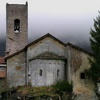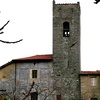Castle of Vallico di Sopra
The village of Vallico di Sopra sits on the summit of a rocky spur on the slope of Monte Penna.. As well as maintaining direct contact with Motrone, the small village also permitted guarding of the path which crosses Monte Penna to reach the top of Monte Gragno, a significance often disputed because of its importance as grazing land and for mountain pasture.
In the village some walls which can be attributed with certainty to the Middle Ages are preserved. It is very likely that the ancient fort stood where there is now the village, and that a small fortress was elevated on the hill to the north. A gate with a ravelin is located at the southern edge of the village: despite the presence of a small arrow slit, this structure probably cannot be traced to mediaeval times but rather to the sixteenth-seventeenth centuries.
Just outside of the village is the Romanesque church of San Michele, with the facade interrupted by blind arches and the apse decorated with hanging arches.
Going up the San Luigi road, along a path that runs along the eastern side of Monte Penna, you can reach the Grotta di Castelvenere. The cave contains evidence of human presence from the fifth century B.C. as is demonstrated by the votive objects and idols found at the site which can now be seen at the Archaeological Museum of the Territory in Castelnuovo Garfagnana and the National Museum of Villa Guinigi in Lucca.
Historical notes
At "Valivo de Supra" a "curtis" already existed in 781, founded on private initiative, which was later bought by the Bishop of Lucca. The village is best known as a simple cluster of houses dependent on the parish of Gallicano according to documents from 854 and 997. Subsequently some written records confirm the presence of a castle: in 1122 the "curtis" together with the "monte et poio seo castello quod vocatur Valivo de Supra" belonged to Guido del fu Mascaro, who sold the property to Bishop Benedetto. Also, in the same year, the men of Vallico swore allegiance to the prelate promising to help maintain control of the fortress of "Sala vel Valivo." After 1355, the fort no longer appears in written documentation.










